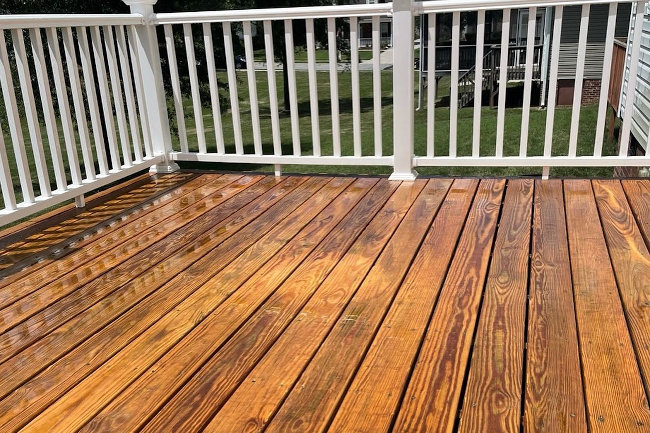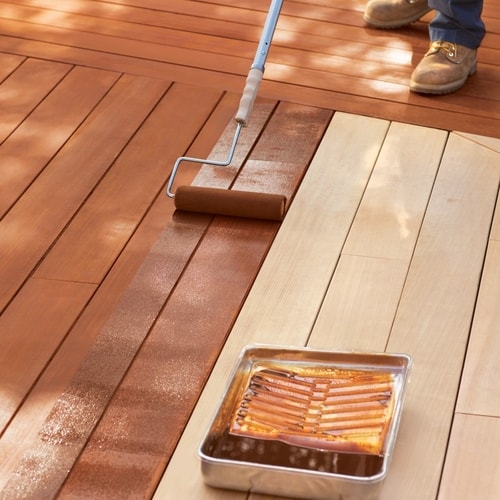Choosing the Right Deck Stain: Improve and Secure Your Deck
Choosing the Right Deck Stain: Improve and Secure Your Deck
Blog Article
A Comprehensive Overview to Various Kinds Of Deck Discoloration Techniques for Ultimate Security and Visual Appeals
In the world of deck maintenance, the art of staining stands as a pivotal step towards both preserving the integrity of your exterior area and boosting its aesthetic allure. As we navigate through the detailed globe of deck staining methods, one starts to value the nuanced methods that can make all the distinction between a sub-par surface and a remarkable one.
Comprehending Different Kinds Of Spots
Various kinds of stains are frequently made use of in the procedure of deck discoloration to achieve different visual and safety effects. On the other hand, semi-transparent discolorations provide an equilibrium between shade enhancement and protection, allowing some timber grain to reveal through.
Toners add a tip of shade to the wood while giving minimal defense, making them appropriate for newer decks with less wear. Comprehending the qualities and advantages of each type of stain is important for attaining the wanted appearance and sturdiness for your deck.
Selecting the Right Discoloration Color
When taking into consideration the visual appeals of your deck discoloration task, the selection of stain shade plays a crucial role in enhancing the protective top qualities of the picked discolor kind (Beautiful Deck). The shade you select can considerably impact the general appearance of your deck, as well as its ability to hold up against the elements with time
When selecting a discolor color, it's vital to consider the existing color system of your home's outside. Harmonizing the deck tarnish with the total visual of your property can develop a cohesive and visually appealing outside space. Additionally, the color of your deck discolor can affect the temperature level of the deck surface area; darker shades tend to absorb more heat, while lighter shades show sunshine and stay cooler.
Furthermore, the kind of wood you are tarnishing will additionally affect just how the stain color shows up. Various wood types can connect with the stain in different means, potentially changing the final shade. It's advisable to check the tarnish on a small, unnoticeable location of the deck to make certain the shade turns out as preferred prior to continuing with the whole project.
Preparing Your Deck for Staining
To guarantee a long-lasting and successful deck staining job, thorough preparation of the deck surface area is vital. Begin by cleaning up the deck extensively to get rid of dust, crud, mold, and any type of old end up or tarnish. Make use of a deck cleaner or a mixture of water and detergent along with a stiff brush or pressure washer to scrub the surface clean. After cleansing, permit the deck to completely dry totally prior to going on to the following action.
Check the deck for any type of damaged or rotten boards that need to be changed. Hammer down any protruding nails and sand any harsh areas to make certain a smooth surface area for staining. Examine for any type of loose barriers or actions that may need tightening or repair.
As soon as the deck is tidy, dry, and in good fixing, think about applying a wood brightener to restore the deck's all-natural shade and open the wood pores for far better stain infiltration. Finally, shield any neighboring plants, furniture, or surface areas with plastic sheet prior to waging the discoloration process. Proper prep work is key to accomplishing a professional-looking coating and optimizing the longevity of your deck discolor.
Using Discoloration With Various Strategies
For a expert and remarkable finish, the technique of using tarnish plays a critical role in improving the appearance and durability of your deck. There are several methods you can make use of to ensure an efficient application of discolor.
Brushing is a traditional technique that permits precision and control over the quantity of stain used. It is optimal for detailed locations and getting to in between deck boards (Water-Based Stains). Rolling is a quicker alternative, covering bigger surface efficiently. Back-brushing after rolling is recommended to also out the tarnish and work it into the timber for far better infiltration.
Spraying have a peek here is one more prominent method, providing speed and ease of application, particularly for huge deck locations. It is very important to utilize a high-grade sprayer and bear in mind overspray. Pad applicators supply a smooth and even end up and are ideal for both horizontal and upright surface areas. Whichever method you choose, making certain proper prep work and complying with manufacturer standards will certainly help attain a lovely and durable stain surface on your deck.

Maintaining and Re-staining Your Deck
Proper this hyperlink maintenance and prompt re-staining are crucial for maintaining the appeal and durability of your deck. Regular maintenance tasks include sweeping debris, cleansing with a deck cleaner, and checking for any type of signs of wear or damages. Resolving problems quickly can prevent extra substantial issues in the future. When it comes to re-staining your deck, the regularity relies on different variables such as the kind of tarnish utilized, the environment in your area, and just how much wear and tear your deck experiences. Typically, it is recommended to re-stain your deck every 2-4 years to keep its security and looks.
Prior to re-staining, ensure the deck is clean, dry, and totally free of any type of previous stain residue. Pick a top notch tarnish that matches your deck's product and gives the preferred level of protection.
Conclusion
To conclude, understanding the different types of deck stains, picking the right color, properly preparing the deck, applying tarnish with numerous strategies, and re-staining the deck and keeping are vital actions for utmost security and looks. By adhering to these actions, you can guarantee that your deck stays in top problem for years ahead.
In addition, the shade of your deck tarnish can influence the temperature level of the deck surface; darker colors tend to soak up even more warm, while lighter colors mirror sunlight and stay cooler.
It's a good idea to check the discolor on a small, low-profile location of the deck to guarantee the address shade turns out as wanted before proceeding with the whole job.

Report this page